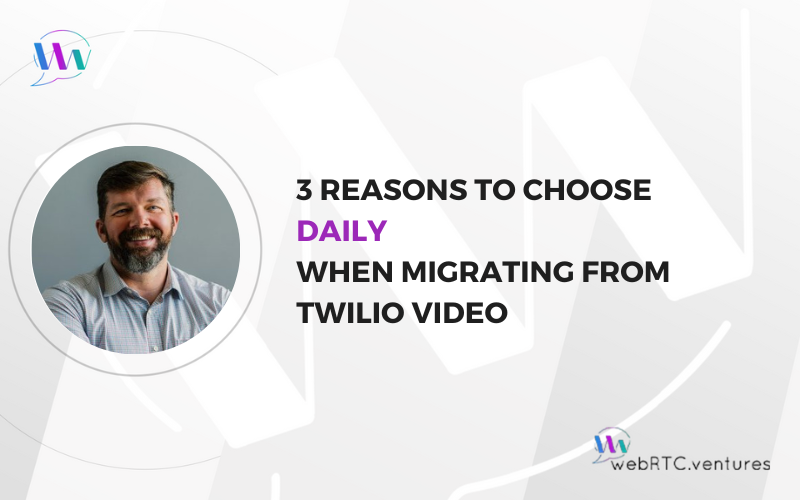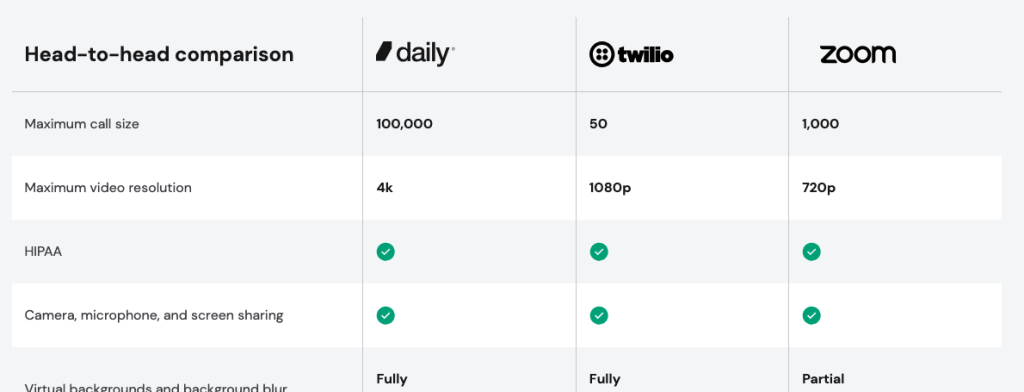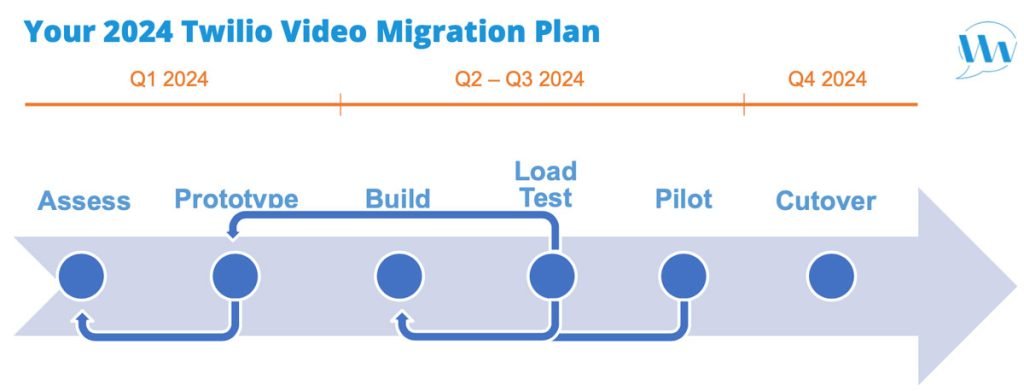Many companies are considering how to gracefully transition from Twilio Video and where to go before it sunsets in December 2024. Earlier this month, I hosted a webinar on this subject with special guests from our expert WebRTC.ventures team. You can find the webinar video and slides, links to presentation resources, and a migration plan timeline on our Migrating From Twilio Video Resource page.
There are many great Communications Platform as a Service (CPaaS) options out there to choose from – and open source media servers, as well. Today, I will review 3 reasons why you might choose Daily when transitioning from Twilio Programmable Video.
For more information, you can also visit:
- Get to market quickly with the Daily WebRTC API (WebRTC.ventures)
- Migrate from Twilio to Daily (Daily.co)
Reason #1: Highly performant and strong feature set
Daily provides impressive quality, including video calls up to industry-best maximum resolution of 4k. Daily reports that 3rd party benchmarking has shown their overall performance to be equivalent to Zoom.
Beyond quality, Daily offers many highly competitive features, including an advertised maximum call size of 100,000. We fielded a number of calls over the years about use cases where Twilio Video users wanted to have real time calls between more than Twilio’s 50 user maximum. Daily can provide that capability.
In addition, Daily provides a rich set of development SDKs, including the less common Python and Linux SDKs in addition to the more common Web, iOS, Android and React Native SDKs. They also have macOS, Flutter, and Windows SDKs in beta now, which is better than Twilio and many other CPaaS’s provide. They also support Dial-in/Dial-out capabilities and SIP video and audio support.
For broadcasting use cases, Daily also supports many useful features including full HD recording, RTMP and HLS live streaming, simulcast, and custom video and audio tracks.
Daily has a head-to-head comparison of their features compared to Twilio and Zoom on their website. Go to their Twilio Migration guide for the full table.
Reason #2: Healthcare ready
Telehealth has always been an interesting area of WebRTC application development, even prior to the pandemic. This is due to the security features built into the WebRTC standard like encryption of the video, audio and data streams.
Still, those built-in encryptions are not enough to ensure HIPAA compliance in the US. Many CPaaS solutions offer additional healthcare security and privacy features in order to support telehealth applications.
Daily has gone beyond the typical features for Telehealth applications like HIPAA compliance and blurred background support. As a large portion of Daily’s clients (~25%) are in telehealth, they have incorporated a number of other AI features and integrations that are useful in healthcare applications, including:
- AI transcription and summarization API
- AI-powered Clinical Notes API
- Real-time transcription and captioning
- AI-powered SOAP Clinical Notes capabilities use a HIPAA-compliant REST API call
- End-to-End encryption also available (though may restrict the use of other features when turned on)
Reason #3: Strong migration path
As mentioned above, Daily has done an excellent job with their Twilio Video migration resources. They provide a lot of helpful information that will help you and your development team (which we are happy to be!)
In addition to excellent documentation, it’s also worth taking a look at Daily’s PreBuilt solution. This is a simple way to test out their platform and so can become part of your prototyping prior to migration away from Twilio Video. (Here’s a blog post I wrote a few years ago on this topic: When to use the Daily Prebuilt Component vs. its Video SDKs.)
Bonus Reason: $30,000 in Development funding!
Daily has made a very public and very compelling offer: $30,000 in development fees or Daily usage credits to qualified Twilio customers. It’s never easy or cheap to make a major architectural change like switching media servers. Daily is helping customers to ease that pain. After qualifying with Daily for this plan, you can choose to have the $30,000 applied towards migration work with our team at WebRTC.ventures, or you can apply it as a credit towards your future Daily platform usage fees. Either way, it’s a compelling discount!
In addition, Daily is available through the AWS Marketplace. If your company has a spend requirement with AWS, you can retire some of that spend by using Daily.
Your 2024 Twilio Video Migration Plan
It was good that Twilio gave everyone a full year to migrate their applications. December 5, 2024 will come up faster than you expect! Based on our experience building live video and communication applications for nearly a decade for a wide range of industries and use cases, we know that building, deploying and testing these applications is often harder than people expect.
Below is our recommendation for your 2024 migration timeline, assuming that you are reading this in Q1 of 2024. If you are reading this later than that, then it’s even more critical that you contact us today so you have enough time to do a high quality cutover.
A successful migration away from Twilio Video should leave enough room for each of these steps:
- Assess
Take some time to compare not just features, but also billing models and technical implementations. We can help you compare multiple architectural considerations.
- Prototype
Every CPaaS implements a few things differently, even when the APIs look similar. You’ll want to prototype your new solution to discover the little things that may have a big impact on your specific workflow. We strongly recommend that you complete the Assessment and Prototyping phases in Q1 2024 in order to leave plenty of time for the hard work that follows.
- Build, Load Test, and Pilot!
After a successful prototype, you obviously need to do the full integration of your new media API into your application. Don’t forget to load test this new implementation and then pilot it with Alpha and Beta users to ensure it performs the way you expect both technically and from a usability perspective. Ideally, you’ll have all of Q2 and Q3 to dedicate to these efforts, so that you can deploy early and confidently in Q4. Make sure you start your pilot well before Q4 though so that you have time to incorporate feedback from users and load testing!
- Cutover
If you started early enough, we recommend doing your deployment early in Q4 2024. Don’t wait until December. Leaving some time allows a temporary rollback, if needed. You will also have better access to the support resources of your new CPaaS, our team, and even Twilio if needed, well before the rush of cutovers in November and December 2024 for those who didn’t get started early.
Don’t get caught at the back of the line!
We expect high demand for our team’s expertise this year. It’s crucial to contact us promptly to secure a slot for your project. Whether you’re seeking consulting and assessment exclusively or require assistance with the complete migration, deployment, and support of your new solution, we’re here to assist. Don’t hesitate—contact us today.













